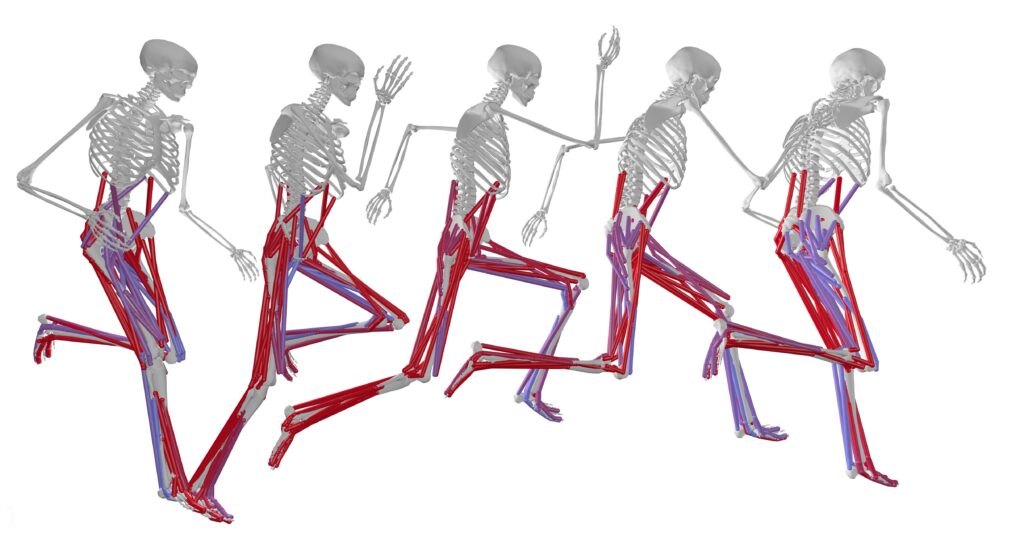In sprinting, where the foot lands may be key to speed
Collaborators

New simulations suggest sprinting coaches may want to focus on one specific technique that could lead to performance gains.
By Kristy Hamilton

Nicos Haralabidis
In elite sprinting and high-speed sports like soccer, fractions of a seconds can make the difference between a podium and going home. Now, a Wu Tsai Human Performance Alliance study in Medicine & Science in Sports & Exercise offers athletes a movement technique that could help boost top sprinting speeds.
To test what makes a sprinter faster, the team used a computer simulation modeled on the stride of an international-level male sprinter. They found that speed can hinge on one detail: horizontal touchdown distance (HTD) – or the spot where the foot lands relative to the body’s center of mass.
Past studies on sprinting technique often compared different athletes, making it hard to untangle the effects of technique from personal traits like strength or coordination.
“In contrast, we used a predictive simulation approach, which permits cause-effect relationships to be explored,” said Nicos Haralabidis, first author of the study and a postdoctoral fellow with the Wu Tsai Human Performance Alliance’s Digital Athlete project. “This makes it possible to determine how modifying a single aspect of technique affects performance. Importantly, our simulation also doesn’t expose athletes to technique modifications that may worsen performance or lead to injury.”

The two main metrics measured: Horizontal touchdown distance (HTD) and inter-knee touchdown distance (IKTD). Nicos Haralabidis. Simulations Reveal how Touchdown Kinematic Variables Affect Top Sprinting Speed: Implications for Coaching. Medicine & Science in Sports & Exercise ():10.1249/MSS.0000000000003797, July 17, 2025. | DOI: 10.1249/MSS.0000000000003797
A 6 cm Mistake That May Slow You Down
The optimal simulation clocked in at 11.85 meters per second, mirroring elite 100-meter sprint speeds. But when the researchers shortened the HTD by 6 cm, speed dropped by 7.3%. Why? The hips likely couldn’t generate as much motion and force, cutting down the powerful push-off from the glutes and hamstrings.
At the other extreme, lengthening the HTD created too much braking. A longer stride increased the foot’s ground contact time and led to greater deceleration forces. This suggests there’s a sweet spot for foot placement – not too short, not too long – if you want to reach top speeds.
“In the future, we hope the findings from this study and others like it can be used by coaches to support and inform the kinematic technique modifications they recommend to athletes to enhance their top sprinting speed.”
Another metric that coaches often monitor – the inter-knee touchdown distance (IKTD), or the distance between knees at touchdown – had little effect on speed.
“It was surprising that modifying IKTD had negligible effect given the strong mechanical basis for this technique variable,” said Haralabidis. However, the model compensated by making subtle adjustments to how the swing leg moved.
Simulations represent a best guess, not a universal truth. The simulation did not account for the accelerative steps that influence an athlete’s ability to reach top speeds. In addition, “it’s challenging to determine how the physical attributes between groups of athletes may affect technique and performance,” said Haralabidis. For example, the model is based on a male, not a female.

Canva Pro Images
Implications for Coaches and Athletes
The study offers coaches a more focused target for training: foot placement at touchdown. In the future, advances in field-based, marker-less motion capture systems may help coaches identify an athlete’s optimal HTD through regular field assessments. The findings also caution against spending too much time on IKTD, at least without stronger evidence.
“In the future, we hope the findings from this study and others like it can be used by coaches to support and inform the kinematic technique modifications they recommend to athletes to enhance their top sprinting speed,” added Haralabidis.
The work highlights how even subtle changes in movement can shape performance. For coaches and athletes, it’s a reminder that progress doesn’t always require bigger muscles or longer hours. Sometimes, it’s about placing your feet in just the right spot.
The research team has made their simulation framework and data publicly available at https://github.com/nicos1993/Pred_Sim_Sprinting.
The study is part of the Wu Tsai Human Performance Alliance Digital Athlete Moonshot.
Co-authors include Ashton Eaton, Jennifer Hicks, and Scott Delp
Latest News

December 10, 2025
Study suggests how eccentric resistance exercises might strengthen tendons

November 21, 2025
Recordings Now Live: Female Athlete Research Meeting 2025

September 23, 2025
In sprinting, where the foot lands may be key to speed
Get Engaged
Join our mailing list to receive the latest information and updates on the Wu Tsai Human Performance Alliance.
